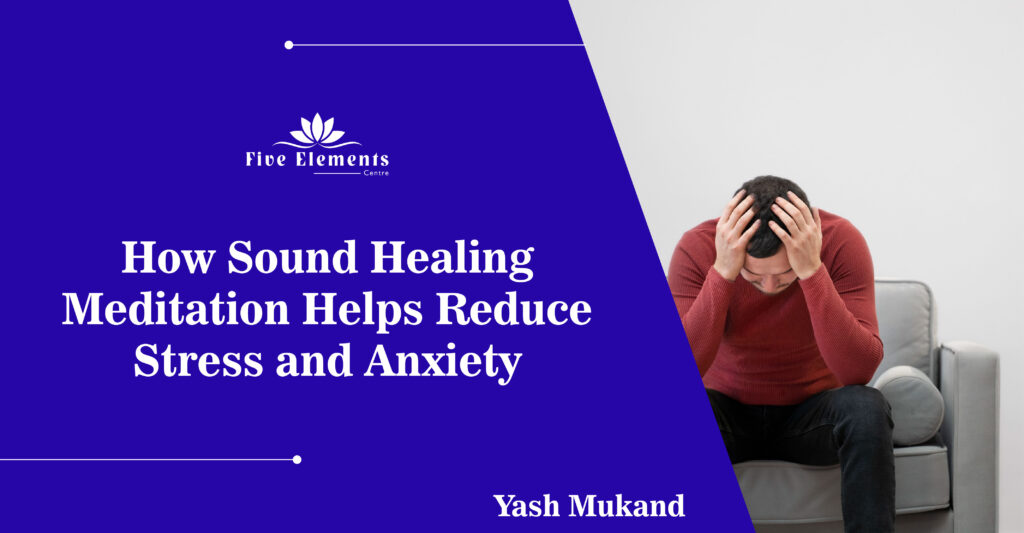Medical Applications of Sound Therapy: A NarrativeReview of Its Efficacy in Treatment and HealingModalities
Yash Mukand Founder Five Elements Centre MA Psychology Abstract Sound therapy is gaining attention in the medical world. The technique of mindfully employing sound and listening to alter and broadenconsciousness in order to strengthen the body’s innate ability to repair and rejuvenate itself is known as sound healing. Sound is avibroacoustic waveform that can be used for both medical and therapeutic purposes. However, this has yet to be sufficiently utilized, andsound treatment in medicine is still mainly unexplored. This present narrative review attempts to shed light on the benefits of sound therapyin the alleviation of symptoms of various medical diseases. Sound therapy is a ground-breaking method of medical care and prevention thatis revolutionising the field of medicine today. Sound therapy offers a non-invasive, easily accessible, and possibly inexpensive techniquethat might be incorporated into more comprehensive treatment regimens. Introduction Sound healing is a particular integrative medicine therapeutic approach that uses vibration. It is also known as sound therapy, soundbath, or sound meditation. Handmade bowls, which resemble bells, along with gongs and other vibrational musical instruments, arecommonly used in sound therapy. Because of the unusual experience that participants have described as the sound and vibration “washing”over their bodies, it has really been dubbed a “sound bath”. Sound healing is a less well-known vibrational healing method that has gainedmore attention recently. It can be thought of as a fusion of some elements of music therapy and meditation (Goldsby et al., 2022). The majority of individuals would assume that music is only utilised for communication, celebration, ceremony, artistic expression,or amusement. Sound healing, a therapeutic approach that uses various signals and vibrations to enhance the mental and physical well-beingof people, communities, and cultures, is another way that music is used. This can involve playing an instrument, chanting, dancing to therhythms of alternative music, meditating, or listening to different musical experiences. One-on-one or in-group instruction may be a part ofspecific treatment from a specialised practitioner. Sessions typically entail sitting or lying down and listening to pre-made music or soundsthat are played over a monitor. These sounds can be produced by specific instruments that have been used for millennia or by applyingfrequency and sound vibrations with the use of specialised instruments like a tuning fork (Pulido, 2001). A vibration that travels through a solid, liquid, or gaseous media as an acoustic wave is called sound, and it is the feeling that isperceived by the unique sense and organ of hearing. The human ear can detect acoustic waves at frequencies between 20 Hz and 20 KHz.Ultrasound and infrasound waves fall above and below this frequency range, respectively (Uğraş, 2018). As a result, sound is an oscillationthat travels through elastic medium like air as waves. It causes the media to vibrate, which causes changes in pressure, particle displacement,as well as velocity (Berg, 2012). However, the medium itself does not follow the sound wave. Compared to liquids or air, sound waves movemore quickly through solids. The human ear interprets their stimulation of the hearing mechanism (organ of Corti) as sound. To put it simply,sound represents a sinusoidal plane wave that has amplitude, speed, direction, wavelength (the inverse of frequency), and frequency (wavesper unit of time). The material used for transmission can reflect, refractively alter, or even attenuate sound waves. This depends on themedium’s density, pressure, velocity, and viscosity (Abagnali, 2011). Sound has amplitude and frequency, and it moves through a medium at a specific speed and in a specific direction. It createsvibrations in a substance by transmitting its waves into it. Each particle of the material has a unique frequency. They start to vibrate in timewith the sound waves as soon as they come into contact with them. Sound therapists have believed since ancient times that the body’s energyfrequencies become out of sync when an illness strikes. These distorted frequencies can be aligned and returned to normal by pure soundgenerated by a variety of devices. It is believed that this will alleviate the illness and help to mitigate the issue. Numerous neuroimagingmethods have demonstrated how music and sound can either stimulate or calm the brain, resulting in certain EEG brain wave alterations. Ona deeper level, sound treatment can cause a sleepy phase in which the brain’s theta waves are more prevalent. This improves memory,consciousness, and intuition while also promoting healing and clear, creative thinking. Neural regeneration processes are thought to beimproved. It eases pain and stress and promotes relaxation. The effect lasts longer and is more profound (Shahid, 2021). Through several vibrations, humans are continuously impacted and altering our rhythms. The alpha and theta brain waves linked todeep meditation, intense creativity, and healing-promoting sleep states can be triggered by these vibrations. Additionally, they lower ourheart and breathing rates, which has a healing effect on both the body and the psyche. Brain waves that are synchronised enable the body toregain homeostasis and lessen any discord. The human body is a great vibration transmitter because it is a bioelectrical system, meaning thatevery cell is a sound resonator that can produce sound outside of itself. It is our voices that possess a special healing potential. Each cell in the human body resonates when we sing. We all have the opportunity totune into the Divine and relieve pain and illness without the use of drugs through sound healing. Sound healing is the therapeutic use ofsound frequencies that stimulate the body/mind of individuals to put them into an optimal state of harmony and wellness. Every organism vibrates at a different rate. There is a resonance frequency that is specific to each item in the cosmos. The vibration of sound is enjoyable toour body’s cells. When two ‘C’ tuning forks are struck and put close to each other, resonance is easily visible. Simultaneously with the firsttuning fork, the subsequent tuning fork will start to resonate. The second tuning fork has received some of the energy from the first one’ssound wave. A metal or glass object will start to vibrate if the struck tuning fork’s stem is put on it (Heather, 2007). For anyone using music



